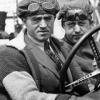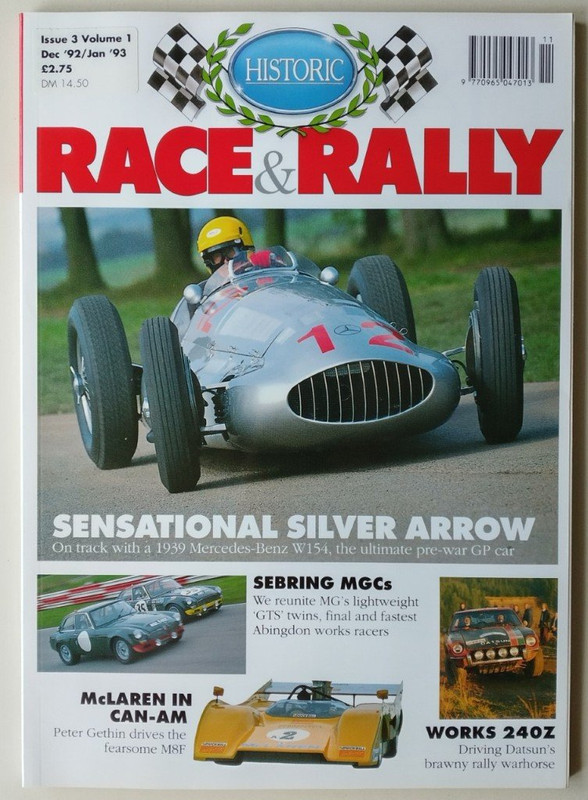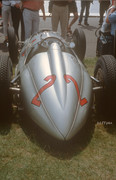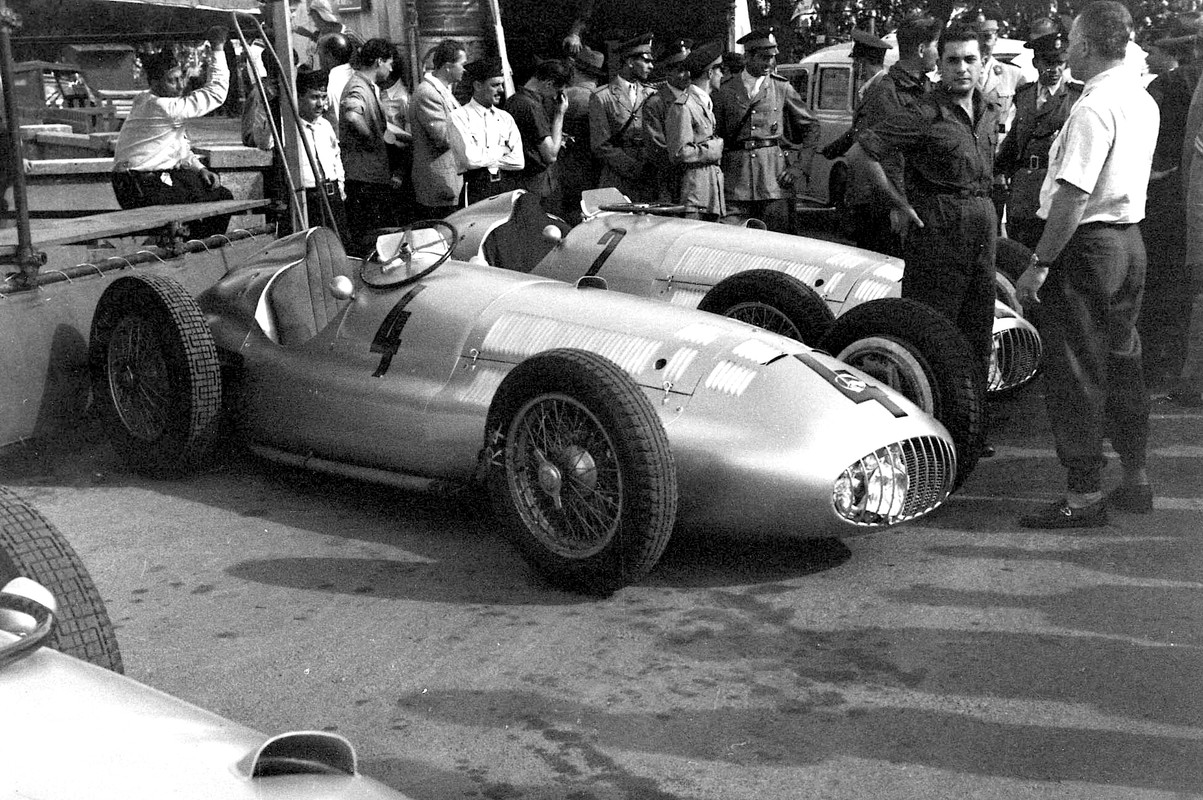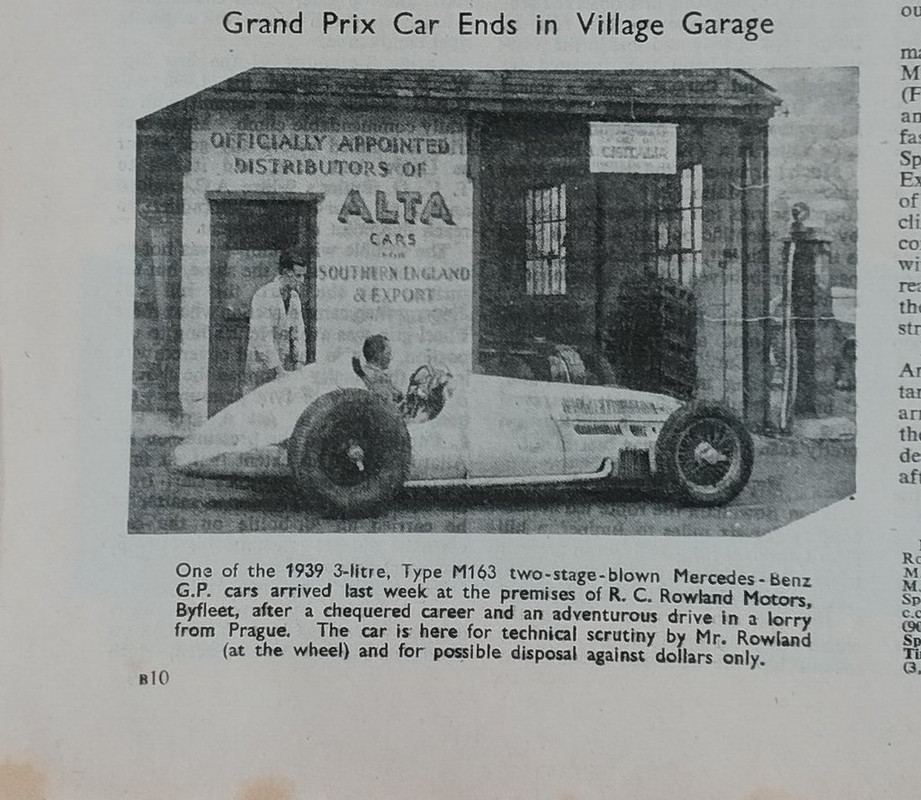W154 survivors
#1

Posted 30 August 2006 - 18:57
I am trying to update the status of the surviving W154's. I'm contemplating a comprehensive book about these cars (1938 and 1939), and about the amazing fact that nine of these have survived for 67 years!
I recently learned that The Collier Collection has obtained chassis #15 as a permanent part of their collection. I have been in contact with them and MAY be allowed to photograph the car sometime next year (for a price), after it has been refurbished. I don't know yet where they got that one.
The most recent info I have regarding disposition is mostly based on Don Capps' postings here (2001, tentative), and I'm sure things may have changed a lot since then.
I have photos of a car that was for sale by Symbolic Motor Cars in CA in 2003 ... then on loan for a while to the Petersen Museum. To me (as a designer) it has the most authentic as-raced-in-1939 nose shape of ANY survivor I've ever seen (I believe there are eight 1939 cars, and one 1938, surviving). The owner of Symbolic told me it was restored by THE FACTORY, and Symbolic sold it to a collector who shall forever remain anonymous, I believe in Romania (Joska Roman? ... Is he an authorized W154 dealer??) . I haven't yet been able to track down the chassis # of that one ... or where it came from before it got to the factory to be restored, etc.
I was never able to find a photo of either Mulhouse car until the one with the "funny" front suspension surfaced at Goodwood this year. Does anyone know anything about their second car?
Number 8 is a quandary, as it was supposedly lost in Poland. I bet it's in an old barn ... or maybe under a haystack!! Wouldn't that be a find!
Ownership of some of these seems to be very secretive; any help with my espionage would be greatly appreciated.
Jim Ferron
Loudon, Tennessee
Wagen 6: Poland, MNA Mulhouse
Wagen 7: Romania, USA California (Arturo Keller collection) (is this the Symbolic/Petersen car?)
Wagen 9: Don Lee, Neil Corner, Czechoslovakia, Germany
Wagen 10: Czechoslovakia, Prague (Technical Museum)
Wagen 11, Works MB Stuttgart, Museum Mercedes-Benz Stuttgart
Wagen 12: Berlin, Museum Mercedes-Benz Stuttgart (the ONLY one with 1938 Bodywork; Is this no longer at the Deutsches Museum?)
Wagen 14: Works MB Stuttgart, Museum Mercedes-Benz Stuttgart
Wagen 15: Romania, Germany (private collection)
Wagen 16: Berlin, MNA Mulhouse
Advertisement
#2

Posted 30 August 2006 - 20:52
DCN
#3

Posted 30 August 2006 - 20:55
#4

Posted 30 August 2006 - 23:27
Any views Doug??
#5

Posted 31 August 2006 - 06:53
Vince Howlett, Victoria, B.C., Canada
#6

Posted 31 August 2006 - 12:32
tam999
#7

Posted 31 August 2006 - 14:30
tam999
If I remember correctly the cars had Ball or Roller bearing instead of inserted bearing! Not a good choice in any event. Keeping an engine together with ball bearing is not a job for amateurs or even for amateurs without a lot of high priced engineers standing looking over their shoulders in any event. One might study the engines in the later German tank engines made by Maybach as an example.
M.L. Anderson
#8

Posted 31 August 2006 - 19:54
oh...motorcycles too.
#9

Posted 03 September 2006 - 22:54
I ran into a book last year that has a lot of useful information on the W154, including a list of where the different cars are now. The list is close to your list. The book is:
Mercedes- Benz Grand Prix Cars 1934-1955
By Louis Sugahara
Mercedes-Benz Classique Car Library (www.classiquecarlibrary.com)
2004
ISBN 1-933123-00
Originally published in Japanese 1997
The book includes a large number of line drawings showing the bodywork configuration of individual cars at specific races. The text includes quite a bit of information on the different GP cars that was new for me, and I have been following the details of the W154 for a number of years.
He mentions the heating of the oil, seen on the Joel Finn car at Monterey. The engine had a very low volume of crankcase capacity to reduce the frontal area of the engine and hence the frontal area of the car. This resulted in overheating of the oil. To keep the oil viscosity at reasonable levels with the engine running at racing speeds the oil was as thick as grease at room temperature. Every night the oil was drained from the engine and put in an oven overnight. The oil was put back in the engine and the engine warmed up with hot plugs. The cold plugs were put in the warmed up engine before the race.
All Mercedes race engines from the 1920's through 1955 had roller bearings, both crank and rod bearings. In the prewar period the roller bearings had split races and cages. The post war W196 and 300 SLR used built up cranks with the Hirth system and one piece cages and races. Most if not all of the Daimler-Benz aircraft engine in WW 2 used roller rod bearings with split cages and rods. In both race cars and aircraft the roller bearing were used because oil and bearing technology at the time was limited and the roller bearings could handle the high bearing loads better than the plain bearings available at the time. The Vandervell bearings were developed for the Merlin.
GMW
#10

Posted 05 September 2006 - 14:54
The one that intrigues me is the photo I had NEVER seen before ... on page 212 of Karl's magnificent Quicksilver Century ... with a grille opening much like a W125 (much narrower than the oft-published March/Monza/Uhlenhaut test car).
Can anyone post a photo of the Thorne car? I have never been able to view the one posted here a few years ago.
The Collier Museum has asked me to forward any info I can round up regarding current disposition of these cars. I'd greatly appreciate it if anyone with real knowledge about this might assist me.
I'll post the most recent list I've come up with in a few days.
Thanks to all!!!!!!!
Jim Ferron
Loudon, TN
USA
#11

Posted 05 September 2006 - 15:35
Connected with Merritt ... I worked with Warren Fitzgerald at GM Styling. He let me drive the only Ferrari I've ever driven (or am likely to!) ... a SWB Tour d'France, around the Tech Center, probably in 2nd gear. He talked Mitchell into letting him buy it in Europe so he could drive it.
Does anybody recall the item I saw in R&T (LONG time ago) about John Bond having acquired the original nose for the W154 and then donating it to the restoration project?
Ain't the Internet beautiful!!!
Jim
#12

Posted 05 September 2006 - 20:53

© Grand Prix Library
#13

Posted 06 September 2006 - 04:37
It's even worse than I feared!
Jim
#14

Posted 09 September 2006 - 03:09
Sugahara includes another photo of this W154 prototype. He credits the photo to The Autocar.
March,1938.
#15

Posted 29 December 2007 - 13:37
Wagen 10 is still sat in the Technical Museum largely unrestored and in really quite poor condition - there is a picture of it in Autodrome.
#17

Posted 29 December 2007 - 18:09
#18

Posted 29 December 2007 - 18:50
#19

Posted 29 December 2007 - 21:57
Just read the bit about only 1/3rd of the cars they have being on show - next time I'm over there I'll arrange to visit and photograph the other 2/3rds - is suggests they rotate them but I've been going there for more than 10 years and none of the cars has moved (or shown any sign of being maintained for that matter)
Advertisement
#20

Posted 29 December 2007 - 22:06
#21

Posted 29 December 2007 - 22:29
Not suprised it being rebuilt - its a bugger to find, and really really communist in its design - it had also been basically abandoned for years - no changes and seemingly no improvements or repais in a decade - matbe since the revolution
#23

Posted 03 February 2022 - 17:20
I'd like to wake up this thread because I'm wondering if we have an updated list of the locations of the W154 survivors.
I see that Jim Ferron promised us one but I haven't seen it.
What's the good word Jim?
#24

Posted 03 February 2022 - 21:22
#25

Posted 04 February 2022 - 09:47
This is an educated guess but I reckon that it's been built up from the show chassis that I first saw at the Deutsches Museum in 1958.
I'm glad they did it because this is in my view the prettiest of the bunch.
#26

Posted 04 February 2022 - 14:02
The book "Mercedes-Benz Renn- und Sportwagen" by Günter Engelen from 2011 lists:
1: scrapped in period
2: scrapped in period
3: unknown
4: scrapped in period
5: scrapped in period
6: Mulhouse/F
7: Keller/US
8: unknown
9: Samsung/ROK
10: Prague/CZ
11: Museum Daimler AG Suttgart/D
12: Mercedes-Benz Classic Stuttgart/D
13: not built
14: Deutsches Museum Munich/D (this is the 1938 car)
15: Collier/US
16: Mulhouse/F
#27

Posted 04 February 2022 - 19:03
I believe they were stored in pairs during WW2? Were 3 and 8 together?
#28

Posted 04 February 2022 - 19:54
Would someone please help me upload a photo of Wagon 11 ? I took it in 1986 in Stuttgart. Thanks ! Jackpaulshea@gmail.com
Edited by tampaguy, 04 February 2022 - 19:56.
#30

Posted 05 February 2022 - 08:37
Originallty posted by tampaguy
Would someone please help me upload a photo of Wagon 11? I took it in 1986 in Stuttgart. Thanks! Jackpaulshea@gmail.com
Is this the one?
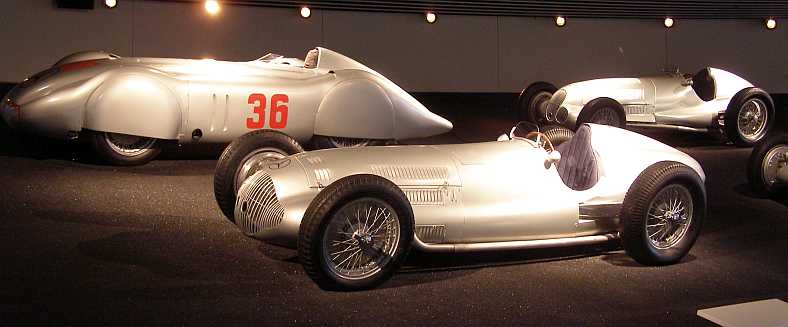
e.mail sent.
#31

Posted 05 February 2022 - 10:30
That's the one! What a beauty!
The 2011 list looks good...but I can't help wondering if any of them have found new homes in the last decade.
Thanks a lot for any and all input.
#32

Posted 05 February 2022 - 10:37
Just another quick comment.
There are distinct differences between the looks of the 1939 cars between their pre-war appearance and the post-war modifications of the noses for the three factory cars that raced in Buenos Aires in 1951. They have noticeably smaller air entries.
#34

Posted 05 February 2022 - 12:00
Karl...
The photographer forgot to put a copyright on that picture if you want to use it for anything. Just e.mail him for a high resolution version if this is so.
#35

Posted 05 February 2022 - 21:19
tampaguy puts forth this picture, taken at the MB museum in 1986:

#36

Posted 05 February 2022 - 21:25
W165?
DCN
#37

Posted 05 February 2022 - 22:46
W165?
DCN
Stimmt.
#38

Posted 05 February 2022 - 22:57
Sorry fellas I had my #’s confused ?
#41

Posted 06 February 2022 - 00:30
W154 at Mulhous in 2016:

Sporting the reduced air intake, eleven vertical bars compared to thirteen in pre-war racing.
#42

Posted 06 February 2022 - 04:15
Those pillars are a pain Ray (I have an identical photo to yours above), but ... Mulhouse 2007:

#43

Posted 06 February 2022 - 05:53
I also have one from that angle...
However, it's a bit dark (I can overcome that) and it has the W125 display board in the spot yours has the W154 board.
#45

Posted 06 February 2022 - 09:51
Zis is very embarrassing! All that rubbish in the Kühleröffnung, ve Germans do not tolerate such Unordnung!! Why are those mechanics standing by idle, and not make every effort to clean the stuff out? Get your toozbrushes out, and go to vork!! ![]()
#46

Posted 06 February 2022 - 10:55
You are one of the few TNF regulars who could offer that post, Michael... Respect! ![]()
DCN
#47

Posted 06 February 2022 - 11:09
Could I humbly suggest that this was in 1951 and not 1952? I am not sure, because I hadn't been born by then, but still........
Edited by Henk Vasmel, 06 February 2022 - 11:10.
#48

Posted 06 February 2022 - 12:35
Quite right -- it was 1951.
And please let's not use W154/163. There's no such animal as I think I was the first to point out.
163 refers only to a new and more rugged engine for the 1939 season, thus M163, In both seasons the car was the W154. And also in 1951. The two types of engine are also identified by H and K in that succession for the workshop.
Any more late news on ownership?
#49

Posted 06 February 2022 - 13:24
Date wrong, granted. But for me 'W154/163' is far more explanatory than 'W154 1938 version' or 'W154 1939 variant'.
And these days most of us know what this nomenclature - only ever intended to be 'helpful' - indicates.
So as far as I am concerned W154/163 it is and will remain. I get pedantic over BRM Type 25 versus BRM P25 - but not where these rather more successful German cars are concerned. ![]()
DCN
#50

Posted 06 February 2022 - 14:28
Much of what I know comes from the writing of the last two posters so this is a request not an intervention. It is my understanding that the M163 was a more rugged V12 (as Karl says) but was not much used in 1939. A revised version of the M154, with 2-stage supercharging, was used most of the time. I believe that an M163 was used in one of the Argentina cars - possibly Lang’s.
is that (broadly) correct?








